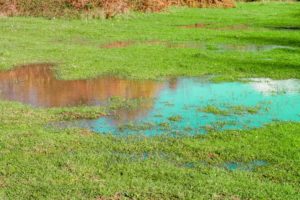
What can you do for your flooded lawn and landscape? Remember these tips.
A flooded lawn can have long-lasting consequences for your landscape and require extensive time and money to fix. Several factors may cause the flooding, so it is essential to figure out why it is occurring. If you have experienced lawn flooding before or want to prevent flooding from happening again, you can take numerous steps to prevent and protect your landscape. Continue reading to learn how to help a flooded lawn recover and how you can be proactive about future landscape care.
Stay Off Your Lawn
If your lawn is flooded, attempt to minimize foot traffic on the lawn. You don’t want to walk across the wet soil, which will be soft and soggy. Walking on wet soil can damage the roots and crowns of your plants and destroy the grass.
Remove Debris From Your Lawn
A rainstorm strong enough to create a flooded lawn is also likely to bring extra debris onto your landscape. Tree branches, trash, and other debris must be removed promptly from your yard. It is best to remove debris with a rake without stepping on your lawn. However, if your yard is large and requires you to walk around, try to minimize your steps. Whenever possible, wait until your lawn has dried out to remove debris and reduce traffic.
Remove Layers of Mulch
You should also remove older mulch from your gardens and landscaped areas. It may seem drastic, but these layers will need to be replaced soon anyway. Some of the mulch may run into your lawn, which can cause some of the flooding. Removing the top layers of mulch can help the drying process in your mulch beds. It is also a beneficial practice on a routine schedule when applying new layers of mulch.
Aerate Your Lawn
You might need to wait a few weeks for your flooded lawn to dry out. Once it has, you can take steps to start revitalizing the lawn. Once new growth appears in the soil, you can start aerating. This helps relieve the compacted soil left behind from the flood. Deep-tine aeration might be a possible solution that helps with the drainage through the soil profile.
Proactive Flood Prevention: Raise Your Lawn
Once you have endured one flooded lawn, you want to avoid future problems. One thing you can do is raise your lawn. When your lawn floods, mark the flooded areas with stakes. Once the water has subsided, cut out the grass in the marked area and rototill to loosen up the soil. You may then raise the lawn with screened topsoil. Next, you can reseed or sod the side. This will help you push the water somewhere else. However, make sure the water won’t just go to another spot in your yard. If so, you may need to install a drainage system.
Install Dry Wells or Subsurface Drainage Systems
A dry well is an empty barrel without a top or bottom and holes in the side. This captures the flood water and holds it underground while slowly releasing it through holes on the side. If your property allows it, subsurface drainage systems like a traditional French drain may also be an appropriate remedy.
Liquid Aeration Products
Modern technology has emerged that helps modify the physical soil particle structure to create porosity that helps with natural drainage. Increased pore space in the soil allows more water to penetrate the soil, which enables expanded root growth that helps improve your lawn’s health naturally. When performed with traditional mechanical aeration, you can achieve maximum health benefits for your lawn’s soil.
Contact the Professionals
Ultimately, it’s best to call the experts when money, time, and your lawn is at stake. If you are unsure of the best course of action to take for your flooded lawn, contact Scientific Plant Service for solutions.
Scientific Plant Service Is Your Go-To Source In Landscape Healthcare
Scientific Plant Service, located in Baltimore, is a privately owned corporation, chartered in Maryland in 1957 by Frank J. Burke. We started as a full-service Arborists specializing in the care of shade trees and ornamental shrubs, but today we are a Lawn Care company that is a huge part of the community. From aquatic environments and snow management to deer and mole control, SPS has services tailored specifically for your lawn and landscape.
We offer services in Maryland, Washington, DC, and Virginia, including: Harford, Baltimore, Carroll, Frederick, Howard, Anne Arundel, Montgomery, Prince Georges, Talbot, Queen Anne’s, Calvert counties in MD, as well as Loudoun County, Fairfax County, Arlington, Alexandria, and Falls Church in VA. For more information, contact us online, or call us at 410-321-0970. Be sure to follow us on Facebook, Twitter, LinkedIn, Instagram, and Pinterest.

